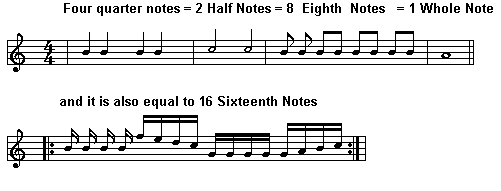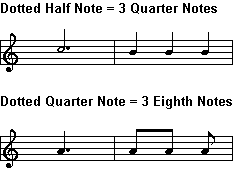Mike Moxcey ©2005
Reading Rhythm
The notes on a line (staff) of sheet music are very specific. There are only so many different notes. The rhythm is a whole other thing entirely. Some folks say you can write any rhythm there is with commonly used notation, but they are wrong. Rhythm runs on a continuum, a smooth line. The notation we use divides a song into measures, and then divides the measures into equal parts. If you have equal rhythmic parts, then this works really well. A lot of popular music has equal rhythmic parts. But as you get into “swinging” a song or “jazzing it up,” the rhythmic indicators are inadequate.
Written rhythm is only an approximation, but it’s useful to get started.
Measures
The basic section of a song is a Measure. Each measure has the same number of beats.
A measure is indicated by a bar (|) or some variation such as a double bar (||) to end a section or a song or repeat bars (||: and :||) which mean repeat everything in-between.
The Time Signature
The Time Signature of a song is that thing that looks like a fraction at the beginning of a piece of sheet music.
- The bottom part tells you what the basic unit of a measure is. A 4 means it’s a quarter note. That’s the most common. A 2 stands for a half note.
- The top part tells you how many of those notes are supposed to be in each measure.
- Therefore, 4/4 time means you will have 4 (the top number) Quarter (the bottom number) notes in each measure.
-
3/4 time means you will have 3 Quarter notes per measure.
- 2/2 time means you will have 2 Half notes per measure.
Note Recipes
The basic note is a quarter note, a black dot with a line (stem) going up or down.
Two quarter notes equal a half note, a circle with a line going up or down.
Two half notes equal a whole note, just a circle with no line.
 You can also split quarter notes in eighth and sixteenth and thirty-second notes.
You can also split quarter notes in eighth and sixteenth and thirty-second notes.
Those notes have flags on the top (or bottom if the stem points down).
An eighth note has one flag, and sixteenth has two flags.
The flags can be joined between similar notes.
Dotted and Slurred Notes
A dot after a note means to make it half again as long. So a half note with a dot afterwards is equal to 3 quarter notes: the two quarters of a half plus half of that which is another quarter. A “dotted” quarter note is 3 eighth notes long. Slurs (curved lines) across two (or more) add the notes together. They are usually used across measure lines.

Reading Music Index


